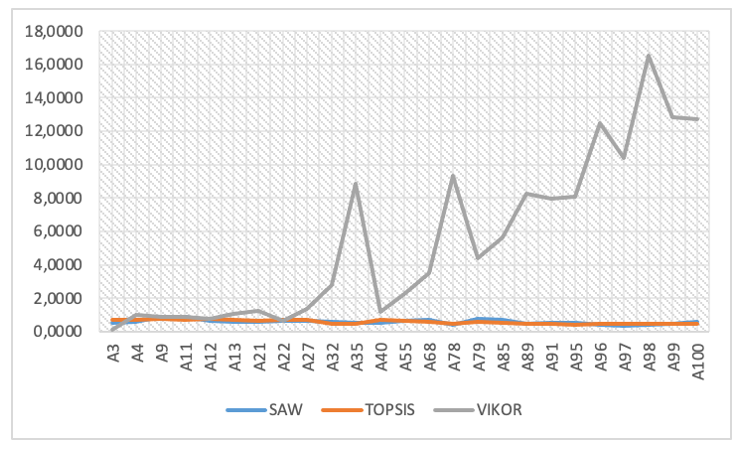Evaluation and Ranking of Urban Drainage Systems Using SAW, TOPSIS, and VIKOR Methods: A Case Study in Bantul Regency
Main Article Content
Muhamad Arifin
Setya Winarno
Sri Kusumadewi
Background: Urban flooding and waterlogging in Bantul Regency stem from inadequate drainage systems, exacerbated by rapid urbanization, land use changes, poor infrastructure planning, and intensified rainfall due to climate change. Therefore, an integrated risk management approach compassing both structural and non-structural solutions—is crucial for improving urban drainage resilience. Conversely, the comprehensive evaluation of drainage system performance continues to pose considerable challenges. Assessments that concentrate solely on hydraulic or technical parameters while neglecting environmental, social, and economic factors—often result in suboptimal or misdirected decisions. As such, adopting a more integrative approach through multi-criteria decision-making methods, such as Multi-Attribute Decision Making (MADM), emerges as a pertinent alternative.
Aims and Methods: The methods employed for MADM analysis in this study include the Simple Additive Weighting (SAW), the Technique for Order Preference by Similarity to Ideal Solution (TOPSIS), and the Vlse Kriterijumska Optimizacija I Kompromisno Resenje (VIKOR). Each of these approaches is designed to accommodate different data characteristics, levels of analytical complexity required, degrees of uncertainty involved, computational load, and the decision maker’s experience or expertise in applying the respective method.
Results: The analysis results indicate that, based on the SAW method, location A11 obtained the highest score (0.8637), signifying the poorest drainage system performance and thus requiring top-priority intervention, whereas location A77 achieved the lowest score (0.3132), indicating a well-functioning drainage condition. Using TOPSIS, location A9 ranked first with a preference value (Vi) of 0.7498, reflecting significant proximity to the ideal solution, while A6 recorded the lowest score (0.2152). Meanwhile, the VIKOR method identified location A99 as the top-ranked alternative with a VIKOR index of 16.5321, while A1 emerged as the lowest-ranked alternative with a VIKOR index of 0.0188.
Ahmad, S., Peng, X., Ashraf, A., Yin, D., Chen, Z., Ahmed, R., Israr, M., & Jia, H. (2025). Building resilient urban drainage systems by integrated flood risk index for evidence-based planning. Journal of Environmental Management, 374(November 2024), 124130. https://doi.org/10.1016/j.jenvman.2025.124130
Arifin, M., Winarno, S., & Kusumadewi, S. (2025). Identifikasi Faktor-Faktor yang Berpengaruh Terhadap Kinerja Sistem Drainase Perkotaan. In A. Hardawati, M. Marasabessy, Irfan, S. Fadilah, M. Hadi, Abdul, A. Laksita, Galuh, & V. Abma (Eds.), The 8th Cereform (Vol. 4, Issue 2, pp. 1–11). https://drive.google.com/file/d/1QC-WMfLSvHIQEWmWQJTOfINOA7n5qKDE/view?usp=sharing
Arya, S., & Kumar, A. (2023). Evaluation of stormwater management approaches and challenges in urban flood control. Urban Climate, 51(August), 101643. https://doi.org/10.1016/j.uclim.2023.101643
Axelsson, C., Giove, S., & Soriani, S. (2021). Urban pluvial flood management part 1: Implementing an ahp-topsis multi-criteria decision analysis method for stakeholder integration in urban climate and stormwater adaptation. Water (Switzerland), 13(17). https://doi.org/10.3390/w13172422
Bakhshipour, A. E., Dittmer, U., Haghighi, A., & Nowak, W. (2021). Toward Sustainable Urban Drainage Infrastructure Planning: A Combined Multiobjective Optimization and Multicriteria Decision-Making Platform. Journal of Water Resources Planning and Management, 147(8). https://doi.org/10.1061/(asce)wr.1943-5452.0001389
Chen, Y. (2021). Application of analytic hierarchy process (AHP) and simple additive weighting (SAW) methods in mapping flood-prone areas. Frontiers in Artificial Intelligence and Applications, 341(2019), 435–441. https://doi.org/10.3233/FAIA210274
Hamdany, F. D., & Saputra, A. J. (2024). The Effect of Urbanization on the Effectiveness of Drainage Systems and Flood Risk in Batam City Pengaruh Urbanisasi terhadap Efektivitas Sistem Drainase dan Risiko Banjir Di Kota Batam. 5(2), 287–291. https://doi.org/10.37253/jcep.v5i2.9619
Min, A. K., & Tashiro, T. (2024). Assessment of pluvial flood events based on monitoring and modeling of an old urban storm drainage in the city center of Yangon, Myanmar. Natural Hazards, 120(9), 8871–8892. https://doi.org/10.1007/s11069-024-06555-8
Rahma, S. L., Sunarsih, S., & Mussadun, M. (2024). Assessing Urban Flooding and Drainage System Performance in Urban Area: A Mononobe Equation and Manning Formula Approach. Jurnal Pengelolaan Sumberdaya Alam Dan Lingkungan, 14(3), 463–470. https://doi.org/10.29244/jpsl.14.3.463
Yang, W., & Zhang, J. (2021). Assessing the performance of gray and green strategies for sustainable urban drainage system development: A multi-criteria decision-making analysis. Journal of Cleaner Production, 293, 126191. https://doi.org/10.1016/j.jclepro.2021.126191
Zhu, S., Feng, H., & Shao, Q. (2023). Evaluating Urban Flood Resilience within the Social-Economic-Natural Complex Ecosystem: A Case Study of Cities in the Yangtze River Delta. Land, 12(6). https://doi.org/10.3390/land12061200








